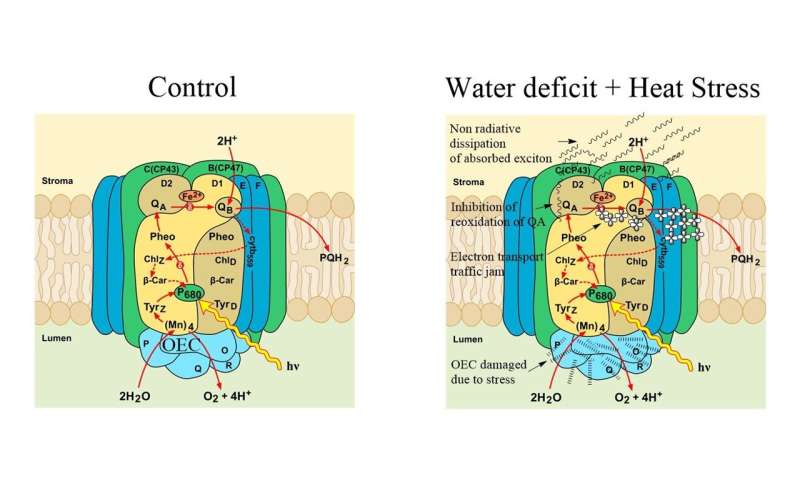Unraveling electron transport dynamics in photosystem II under water deficit and heat stress in pearl millet

Heat and water deficit stresses tend to impede and restrict the efficiency of photosynthesis, chlorophyll fluorescence and maximum photochemical quantum yield in plants based on their characteristic ability to interfere with the electron transport system in photosystem II. Dissection of the electron transport pathway in photosystem II (PS II) under water deficit and heat stress can shed light on the various attributes of the photosynthetic performance of a plant.
We hypothesize that, during stress, specific strategies that can confer adaptive advantages can be employed by plants in terms of changes in photosystem II dynamics, and this can help the plants acquire new homeostasis, which can be a protective adaptation.
Our study on the abiotic stress mechanism in pearl millet has identified details of how electron transport in the PS II of the pearl millet plant is affected by water stress and heat stress in isolation and combination. Stress due to water deficit and heat stress are closely related in the nature of their incidence, and also in the way they affect plants.
This stress in combination is a typical manifestation of the changing climate in the tropics. Drought in the tropics can last for several weeks, and heat can be experienced by the crops as waves or hot spells and is more often accompanied by water deficit. We conducted an experiment by simulating water stress and heat at environmentally relevant proportions to mimic a changing climate scenario at a key crop growth phase.
We dissected the electron transport pathway and quantified it in photosystem II with a chlorophyll fluorescence meter at a saturating light intensity of 3,000 μmol m−2 s−1 with measurements at a high-time resolution of 10 μs.
The oxygen evolution complex (OEC) is a part of the photosystem II that splits water and is instrumental in the release of oxygen in the atmosphere through the photosynthetic process. The oxygen evolution complex changes were quantified in our study and we found that OEC damage is the primary effect of heat stress and is not seen with the same intensity in the water-stressed plants. Low exciton absorption flux in heat stress and combined stress was seen due to OEC damage, and this caused an electron transport traffic jam in the donor side of PS II.
Our results indicate that the functional state of PS II is sensitive to stress, and differential sensitivity was demonstrated in our study where heat and combined heat and water deficit affected PS II electron transport more severely than water-deficit stress in isolation.
We developed flux models and found that both the specific energy flux model and the phenomenological flux model developed from the derived values in our study show that water deficit stress in combination with heat stress has a much stronger effect than the stresses in isolation on the overall electron transport pathway of the PS II in pearl millet plants.
Conclusion
We have proposed that pearl millet, which is an inherently drought and heat-tolerant crop, can serve as a model crop for climate change studies in the tropics. Abiotic stress in general and heat and water stress in particular affect PS II functioning in plants. They alter the electron transport pathway, which can be seen as a response to stressful stimuli or it can be the result of an adaptive mechanism to overcome the stressful stimuli. Our high-resolution dissection of the electron transport pathway in PS II has uncovered how these responses work.
We found that a combination of stress can elicit a different response as compared to stresses in isolation. Our attempt was to answer these questions with a detailed study of chlorophyll fast fluorescence kinetics and non-photochemical quenching (NPQ) under these stresses in pearl millet (Pennisetum glaucum [L.] R. Br.) in isolation and combination.
Our study, now published in Frontiers in Plant Science, reveals the mechanism by which these stresses alter PS II functioning, specifically, the electron transport pathway. The results can further our understanding of combined water deficit and heat stress response. It can pave the way for trait discovery and a further selection of useful drought tolerance traits to evolve climate-ready cultivars.
This story is part of Science X Dialog, where researchers can report findings from their published research articles. Visit this page for information about ScienceX Dialog and how to participate.
More information:
Arun K. Shanker et al, High-resolution dissection of photosystem II electron transport reveals differential response to water deficit and heat stress in isolation and combination in pearl millet [Pennisetum glaucum (L.) R. Br.], Frontiers in Plant Science (2022). DOI: 10.3389/fpls.2022.892676
Arun K. Shanker is serving as a Principal Scientist (Plant Physiology) with the Indian Council of Agricultural Research (ICAR) at the Central Research Institute for Dryland Agriculture in Hyderabad, India. He is working with the ICAR as a full-time researcher since 1993 and has since earned an advanced degree in Crop Physiology from Tamil Nadu Agricultural University while in service. He is presently working on a systems biology approach to study the mechanism of abiotic stress tolerance in crops. His main focus now is to unravel the mechanism of drought and heat stress response in plants to tackle climate change-related threats in agriculture.